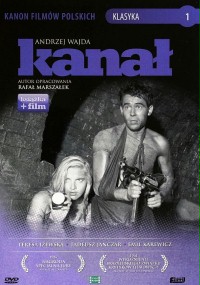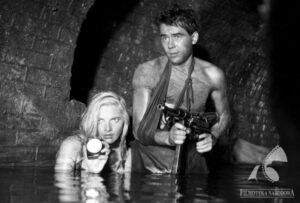“Kanal” – Tragic Fate of the Heroes

Title: “Kanal” (pol. “Kanał”)
Release Date: 1956
Director: Andrzej Wajda
Cast: Tadeusz Janczar, Teresa Iżewska, Wieńczysław Gliński, Tadeusz Gwiazdowski, Stanisław Mikulski, Emil Karewicz, Władysław Sheybal, Teresa Berezowska
“Here are the last hours of these people’s lives. Look carefully,” the prologue of “Kanal” immediately introduces the viewer to the tragic dimension of the story depicted. Andrzej Wajda’s film was the first work in Polish cinema about the Warsaw Uprising. Audiences received it with mixed feelings, as they expected a story of heroic heroism, while on the screen we see characters who are tragic, but at the same time not devoid of such emotions as fear or doubt. Only the international success of the film contributed to its re-reading. Today “Kanal” is a classic of the Polish Film School.
“Kanal” – a short story by Jerzy Stefan Stawinski
Throughout the Stalinist period, the Warsaw Uprising was a taboo subject; the opportunity to tell Poles their recent history in cinema only appeared in 1956, during the Thaw. Andrzej Wajda did it, and the basis of his masterpiece, “Kanal”, became the screenplay by Jerzy Stefan Stawinski. It was based on a short story by this very author, in which Stawinski’s own memories of his participation in the uprising.
The plot of the film takes place at the end of the Warsaw uprising, exactly on the 56th day. It is the end of September 1944. A Home Army company under the command of Lieutenant Zadra (Wienczyslaw Glinski) is still defending its positions in Mokotow. However, everyone is aware that the battle is coming to an end. The soldiers receive orders to leave the district and make their way through the sewers to Srodmiescie, which is still in the hands of the insurgents. Zadra initially rebels against such a decision, he believes that his brave soldiers do not deserve to “like rats” flee through the sewer from the enemy. Eventually, however, the entire company moves to the underground.

During a hasty march, the soldiers inadvertently split into three groups. Stokrotka (Teresa Iżewska), a liaison officer, as the only one who knows the way, leads the wounded Korab (Tadeusz Janczar), with whom she is in love. Zadra with Smukły (Stanisław Mikulski) and the rest of the soldiers try to orient themselves in the labyrinths of the sewers on their own. So does the third group: Wise (Emil Karewicz) with his partner Halinka (Teresa Berezowska) and the musician Ogromny (Wladyslaw Sheybal), crazed with despair.
They all end tragically: Stokrotka and Korab reach a collector on the Vistula River, but it turns out that the Germans have barred the outlet, and they themselves are too exhausted to go any further. Halinka, when she discovers that her beloved is married, shoots herself in the head, Ogromny loses his mind, and Wise leaves the sewer at the spot where the Germans capture and murder insurgents. Only Zadra reaches the city center. However, when the lieutenant realizes that he was deceived by the company chief, who pretended that the rest were following them, he kills the soldier for treason and goes back down into the canal to find his boys.
The film “Kanal” and its telling structure
The “Kanal” has an expressive and symbolic structure. The movie is divided into two parts, the first of which, takes place “on the surface” – in Mokotow, in the brightness of the day, and fills with a certain optimism. The characters stick together, experience brief moments of relaxation when they get to the ruins of a luxurious house or joy when they manage to stop a German tank with the last shell. The second part of the work takes place in the underground – in the dark sewers, a claustrophobic, labyrinthine space from which every exit leads to death. This perspective of seeing “from below” will be repeated later in the “civilian” and at the same time literary account of those days by Miron Bialoszewski – Diary of the Warsaw Uprising.

The film “Kanal” was not shot in an authentic canal, we are dealing here with artificial scenery, but the handling of chiaroscuro and specific music, reminiscent of sounds from the afterlife, gave the whole a very distinctive atmosphere. Combined with a reference to Dante’s Divine Comedy (the musician quotes a passage from the Inferno), the heroes’ journey through the infernal underworld takes on an expressionistic quality. It was also seen as clearly inspired by French existentialism.
“Kanal” in Poland – the heroes are tired
The premiere of “Kanal” in Poland was not met with much enthusiasm. Wajda’s movie was accused of lack of attention to historical detail and, above all, the deheroized face of the insurgents, which did not bring the expected solace to viewers. After all, Poles wanted a story about the days of hope, the glory of the national uprising and the solidarity of the people of Warsaw. Wajda, meanwhile, skipped this uplifting stage of the uprising altogether, focusing on its decline, when the mood of many people collapsed, and the crushing superiority of the enemy and the lack of outside help fueled pessimism. It was still too early for such a film.
The fate of the Polish reception of “Kanal”, however, was changed by Wajda’s international success. The work was the first Polish film in history to be awarded the Silver Palm at Cannes. What’s more, it was awarded ex aequo with The Seventh Seal by Ingmar Bergman himself. This dazzling success reevaluated popular attitudes toward Kanal. In addition, it was not insignificant that in the meantime the novels Kolumbowie rocznik 20 by Roman Bratny and Zośka i Parasol by Aleksander Kamiński, which told the story of the war from the factual and biographical side, had been published.
“Kanal” and the Polish Film School

“Kanal” was thus accepted with its fatalistic narrative, although it did not build a monument to the insurgents, but highlighted the shocking drama of their fate. He showed the human face of the heroes, in which courage was mixed with fear, doubt and sometimes the ordinary desire to survive at all costs. Wajda also did not hesitate to deheroize the soldiers in the moral sphere of their erotic relationships, as later described, for example, by Czeslaw Milosz in his biographical “Native Realm”.
Although the director had already made a high-profile war-themed film, Pokolenie, it was “Kanal” that was hailed as the work-precursor of the Polish Film School (See The Beginning of the Polish Film School), whose main distinguishing feature became the construction of feature films that were a kind of group therapy for Poles, working through the traumas of the national past.
Literature:
Kino klasyczne, pod red. T. Lubelskiego, I. Sowińskiej i R. Syski, Kraków 2012.
A.Garbicz, J. Klinowski, Kino wehikuł magiczny. Przewodnik osiągnięć filmu fabularnego. Podróż druga 1950 – 1959, Kraków 1987.
